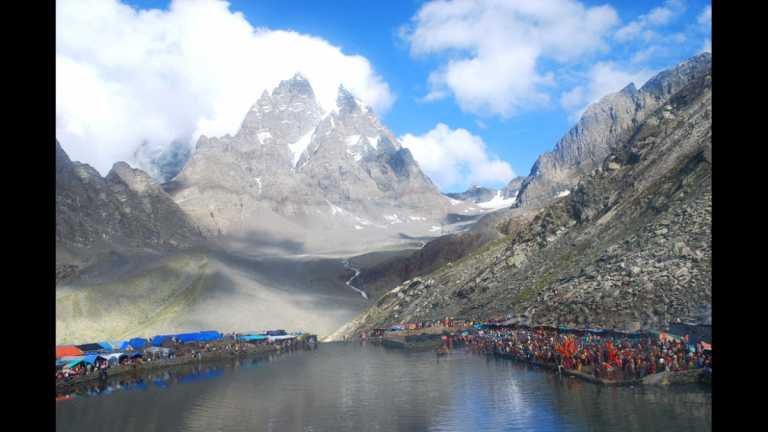
The monsoon rain unleashes its watery load over the mountains, the springs and rivers overflow, a landslide or two just isn’t unusual. However nothing can deter the pilgrims from persevering with with their journey. They’re on their solution to take a holy dip within the glacial lake (perched at over 13,000 ft) which lies on the foothills of the Manimahesh Kailash peak (18,546 ft) deep contained in the northern Indian state of Himachal Pradesh. Normally, the lake stays frozen for the better a part of the 12 months, and it is just after the snow melts in summer season that the path is revealed. The competition, generally known as the Manimahesh Yatra, is devoted to Shiva. It often begins on Janmastami (when the remainder of the nation is celebrating the birthday of Krishna) and concludes on the day of Radhastami.

Bharmour, a small city, about 64km away from Chamba, is the gateway to Manimahesh. The city itself is a picturesque place, surrounded by the Pir Panjal and Dhauladhar ranges. The chhari yatra ranging from Chamba city marks the start of the competition when clergymen and pilgrims carrying the workers with the signal of Manimahesh, the trident and oher holy objects symbolically related to Shiva set off in a procession.
Though the origin of the yatra just isn’t very clear, it’s stated that the native Gaddi tribe has been worshipping the Manimahesh peak because the abode of Shiva since time immemorial. In accordance with native lore, Manimahesh means the ‘jewel of Shiva’. Apparently, on a transparent day, the height dazzles like a diamond below the daybreak lit sky. The meadow on the base of the hills is known as the chaugan of Shiva.Innumerable legends encompass this peak. The smaller peaks under the primary peak are stated to be a shepherd and his flock of sheep frozen to stone by divine wrath for disobeying a rule that forbade anybody from climbing the sacrosanct peak. One other story talks of a snake which had been equally frozen.
The motorable highway goes as much as Hadsar (about 12km from Bharmour).However the ultimate 13 km (roughly) to the lake needs to be coated on foot, a part of it via some very tough terrain. In case you are in a rush, there’s a heli-taxi service from Bharmour. Many pilgrims cease at Dhanchho, a village between Hadsar and Manimahesh, to spend the night time, earlier than continuing to the Manimahesh Lake. The waterfall at Dhanchho is a should see. In accordance with native customs, women and men cease on the lakes named Shiva Krotri and Gauri Kund, respectively, for a shower, earlier than continuing to Manimahesh. Right here they provide prayers on the idol of Shiva after the dip within the lake.

Even if you’re not spiritually inclined, visiting the Manimahesh Lake throughout the yatra is prone to be a rewarding expertise if you’re considering images and native tradition. The meadows on solution to the lake are sometimes house to numerous alpine flowers. On a good day, you’ll catch the reflection of the snow peaks within the blue waters of the oval formed glacial lake.
After a go to to the lake, chances are you’ll spend a few days, having fun with the scenic magnificence and the architectural legacy in and round Bharmour and Chamba.
The Chaurasi temple sq. in Bharmour encloses 84 shrines constructed between the seventh -Tenth centuries. The temple of Bharmani Devi stands on a steep forested slope, about 4km from city. Climate allowing, chances are you’ll go an tour to Salooni (56km away) and to the Bhandal Valley (22km from Salooni). The area is thought for a sweeping view of the snow peaks and the alpine wildlife.
Moreover its pure magnificence, Chamba is a repository of native artwork and structure. The city sprawls alongside the financial institution of the Ravi River. The Lakshmi Narayan temple is the oldest temple of the group of six stone temples depicting the eighth century shikhara type of structure. The Bajreswari temple is one other temple with tremendous carvings. The eleventh century Hari Rai Temple comprises a finely crafted four-armed bronze statue of Lord Vishnu. The Chamunda Devi temple, away from the city centre, is famous for its woodwork. Chamba is among the locations that fostered the Pahari Faculty of miniature portray. A go to to the Bhuri Singh Museum closed on Mondays and different holidays) will acquaint you with these native arts. A should purchase in Chamba is the exquisitely embroidered ‘rumal’ (scarf).
Info: The Manimahesh Yatra in 2022 is scheduled to be held from August 19 to September 2. In accordance with native media studies, these visiting Manimahesh throughout the yatra interval this 12 months should mandatorily register themselves with the native administration and pay a per head charge of Rs 20. The route via Kugti won’t be opened for the yatra this 12 months, studies stated. It’s higher to acquaint your self with the most recent well being associated guidelines by contacting Himachal Pradesh Tourism workplaces earlier than planning.
By highway, Chamba, essentially the most handy gateway for Manimahesh, is about 120km from Pathankot, which can also be the closest rail head and airport. Gaggal airport in Kangra is about 150km by highway from Chamba. There are accommodations in Chamba and Bharmour, together with HPTDC vacationer lodges in Chamba and Bharmour. Lodging in Dhanchho is fundamental at greatest.
This 12 months, in accordance with media studies, the administration has authorized heli-taxi service by two personal corporations; these will probably be out there between August 12 and September 2, between Bharmour and Gaurikund.